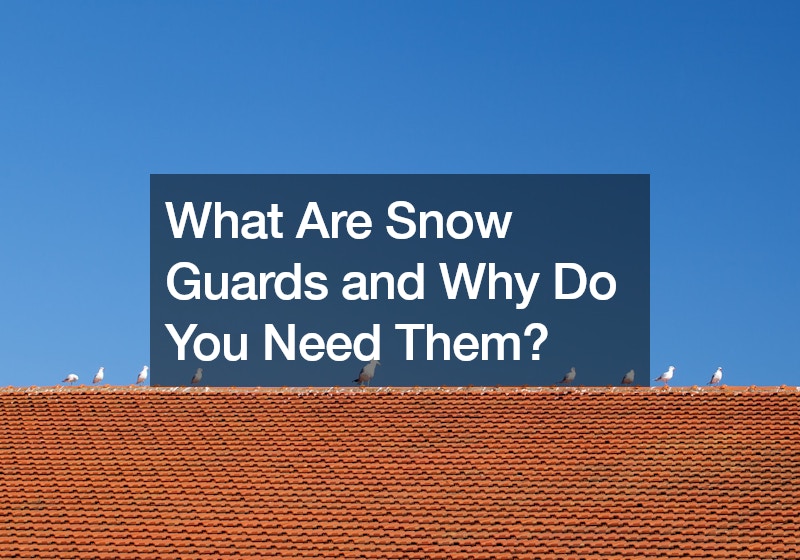
Understanding Snow Guards:
Snow guards, also known as snow retention systems, are specialized devices installed on roofs to prevent the sudden release of accumulated snow and ice. Typically made of plastic or metal, these components are strategically placed along the eaves or edges of a roof to impede the sliding of snow and ice, reducing the potential for damage or injury below.
The Need for Snow Guards:
The need for snow guards becomes apparent in regions where heavy snowfall is a common occurrence. Without adequate protection, snow and ice can accumulate on a roof’s surface, posing significant risks when they suddenly slide off in large quantities, known as roof avalanches. These avalanches can damage gutters, landscaping, vehicles, and even injure unsuspecting passersby.
For homeowners with metal roofs, the importance of snow guards is particularly pronounced. Metal roofs, while durable and long-lasting, have a smooth surface that allows snow to slide off easily. While this feature can be advantageous in some situations, it can also pose a hazard when snow accumulates and suddenly slides off in large chunks. Metal roof snow guards are specifically designed to address this issue by holding the snow in place, preventing it from sliding off all at once.
Types of Snow Guards:
Snow guards come in various types, each with its unique design and installation method. The most common types include:
1. Clips: These are small, inexpensive components that can be easily installed along the roof’s surface using screws or adhesive. While clips are budget-friendly and straightforward to install, they may require frequent maintenance and can potentially damage the roof surface if not installed correctly.
2. Bars: Bar systems consist of stainless steel or aluminum bars installed horizontally across the roof’s surface. These bars provide a sleek and modern appearance while effectively holding the snow in place. Although more expensive than clips, bar systems offer superior durability and require minimal maintenance.
3. Fence Systems: Fence snow guards are installed along the roof’s edges, resembling miniature fences. These systems provide comprehensive protection against roof avalanches and are often preferred for their aesthetic appeal and structural integrity. However, they tend to be the most expensive option due to their intricate design and installation requirements.
3. Snow Guard Maintenance Tips:
Snow guards play a critical role in preventing snow buildup and dangerous roof avalanches during winter, but like any roofing component, they require regular maintenance to ensure optimal performance and longevity. Here are some essential maintenance tips for snow guards:
Inspect Regularly: Perform visual inspections of your snow guards at least once a year, preferably before the winter season begins. Look for signs of damage, such as cracks, breaks, or loose components, and address any issues promptly.
Clear Debris: Remove any debris, such as leaves, branches, or ice buildup, from the surface of the snow guards. Accumulated debris can interfere with the guards’ effectiveness and lead to water pooling or damage to the roof.
Check Attachment Points: Inspect the attachment points of the snow guards, whether adhesive or screw-mounted, to ensure they are securely fastened to the roof. Tighten screws if necessary and reapply adhesive as needed to maintain a strong bond.
Trim Overhanging Branches: Trim any overhanging tree branches that could potentially damage the snow guards during heavy snowfall or windy conditions. Falling branches can dislodge guards and compromise their effectiveness.
Remove Snow Buildup: After significant snowfall, carefully remove snow buildup from the roof to prevent excessive weight and pressure on the snow guards. Use a roof rake or snow removal tool to clear snow safely from the roof surface.
Monitor Performance: Keep an eye on the performance of your snow guards throughout the winter season. If you notice any signs of snow accumulation or roof avalanches, inspect the guards for damage and make any necessary adjustments or repairs.
Schedule Professional Inspection: Consider scheduling a professional inspection of your snow guards and roof system annually to identify any potential issues and ensure proper functioning. A qualified roofing contractor can assess the condition of your snow guards and recommend any necessary repairs or replacements.
By following these maintenance tips and keeping your snow guards in good condition, you can help protect your home from roof avalanches and ensure the safety and integrity of your roof system during the winter months. Regular maintenance is key to maximizing the lifespan and effectiveness of your snow guards, ultimately saving you time and money on costly repairs.
Conclusion:
In conclusion, snow guards are essential components for protecting property and ensuring safety in snowy regions. For homeowners with metal roofs, investing in metal roof snow guards is crucial to prevent roof avalanches and the associated damage and risks. Whether opting for clips, bars, or fence systems, the key is to choose a solution that balances cost, durability, and effectiveness. By installing snow guards, homeowners can enjoy peace of mind knowing that their property and loved ones are protected, even in the harshest winter conditions.
.






